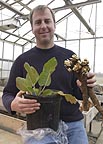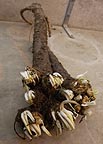January 31, 2006
Walters takes over horseradish breeding program
CARBONDALE, Ill. -- S. Alan Walters, Southern Illinois University Carbondale's Vegetable Guru, has taken on the mantle of the state's Head Horseradish Breeder.
Longtime University of Illinois extension educator C. Chris Doll has called it quits after 40 years of service to farmers in southwestern Illinois, handing over his horseradish breeding program to Walters.
"I had a year with him just to get my feet wet, but this year, I'm on my own," Walters said.
"We're going to try to develop some really good cultivars for the growers, who have one of the most active industry groups in the state. They're very interested in research that will make their product better so they can better compete in the market — both in the U.S. and beyond."
The group is small, but mighty. Some 20 growers produce more than half the nation's horseradish on roughly 1,600 acres in the Metro East/Collinsville area.
"The soils there are perfect for horseradish — deep, rich, moist and loamy," Walters said. The area's sandy loam soils produce a horseradish that packs a particularly pungent punch.
Most of the crop winds up as a condiment, either as the straight stuff that devotees slather onto steaks and roast beef sandwiches or as one of the ingredients that puts the pucker into something like seafood sauce.
"But the product line is getting bigger," Walters noted.
"Horseradish is being mixed with fruit, so you have apple-radish or pineapple-radish, and being mixed with mustard to make it spicier."
A member of the cabbage family, horseradish is subject to very few diseases, but those it does contract usually cause great damage. An ailment called verticillium wilt has growers especially concerned.
"It discolors the root," Walters said. "When you cut one in half, you might see little black spots — that's called ‘peppering' — or sometimes the whole root is black.
"The root still has most of its pungency, but the processors want a clean, white product. You can bleach the roots, but that adds to the cost and cuts into profits.
"This is the main reason that we're involved in horseradish breeding — trying to develop some new cultivars that have resistance to this particular pathogen."
As with such crop killers as soybean sudden death syndrome or soybean cyst nematode, once this fungal disease infests a field, it can stick around for a long, long time.
"It has resting spores that stay in the soil, even with an adequate rotation," Walters said.
"And if you don't get rid of volunteer horseradish, it's like growing continuous horseradish — you don't achieve the purpose of rotation."
Most of Southern Illinois' horseradish fields have wilt infestations, and the pace of development in the Metro East area means no new land will come available.
"The growers know if they're going to combat this problem, it's going to be through breeding," Walters said.
While a cultivar with some resistance already exists, it's not a popular choice because of its bark-like exterior.
"In addition to disease resistance, growers need a quality cultivar with outstanding yields," Walters said.
He is working with some of the Illinois Horseradish Growers Association's germplasm, trying to put this resistance into the top cultivars. He makes his crosses and grows his seedlings in his SIUC greenhouse, but plants them out in research plots on growers' farms. Last June, he harvested seed from the very first crosses he made in the spring. He'll be planting those seeds in March. It will take two months for them to reach transplant size. He will then plant the seedlings in growers' fields, let them grow through the summer, and then evaluate how well they yield and resist disease in the fall.
"The ones that do well over a long period of time in field trials will be elevated to new cultivar status," Walters said.
"It's a long process. It's going to take seven, eight, 10 years to come up with something usable."
Leading in research, scholarly and creative activities is among the goals of Southern at 150: Building Excellence Through Commitment, the blueprint the University is following as it approaches its 150th anniversary in 2019.

Roots — Horseradish
grows not from seed
but from small root
cuttings or sets, seen
here at the bottom of
the main root.
Download Photo Here

The root of the matter —
In his research greenhouse
at Southern Illinois
University Carbondale,
S. Alan Walters shows
what horseradish looks
like before being processed.
The bottled stuff comes from
the main brown root, The
small, white set roots will
become next year’s crop.
Download Photo Here
